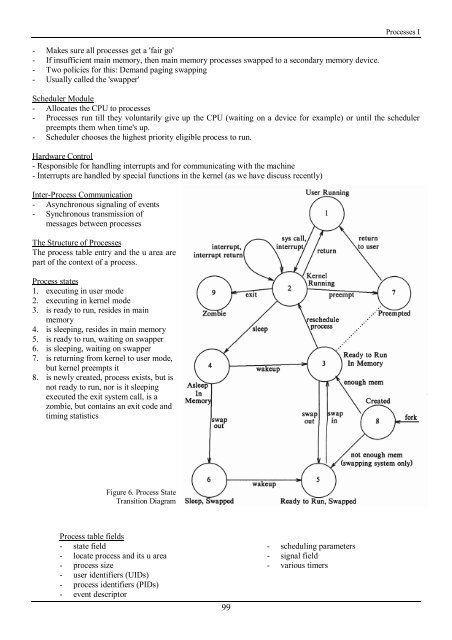You also want an ePaper? Increase the reach of your titles
YUMPU automatically turns print PDFs into web optimized ePapers that Google loves.
Processes I<br />
- Makes sure all processes get a 'fair go'<br />
- If insufficient main memory, <strong>the</strong>n main memory processes swapped to a secondary memory device.<br />
- Two policies for this: Demand paging swapping<br />
- Usually called <strong>the</strong> 'swapper'<br />
Scheduler Module<br />
- Allocates <strong>the</strong> CPU to processes<br />
- Processes run till <strong>the</strong>y voluntarily give up <strong>the</strong> CPU (waiting on a device for example) or until <strong>the</strong> scheduler<br />
preempts <strong>the</strong>m when time's up.<br />
- Scheduler chooses <strong>the</strong> highest priority eligible process to run.<br />
Hardware Control<br />
- Responsible for handling interrupts and for communicating <strong>with</strong> <strong>the</strong> machine<br />
- Interrupts are handled by special functions in <strong>the</strong> kernel (as we have discuss recently)<br />
Inter-Process Communication<br />
- Asynchronous signaling of events<br />
- Synchronous transmission of<br />
messages between processes<br />
The Structure of Processes<br />
The process table entry and <strong>the</strong> u area are<br />
part of <strong>the</strong> context of a process.<br />
Process states<br />
1. executing in user mode<br />
2. executing in kernel mode<br />
3. is ready to run, resides in main<br />
memory<br />
4. is sleeping, resides in main memory<br />
5. is ready to run, waiting on swapper<br />
6. is sleeping, waiting on swapper<br />
7. is returning from kernel to user mode,<br />
but kernel preempts it<br />
8. is newly created, process exists, but is<br />
not ready to run, nor is it sleeping<br />
executed <strong>the</strong> exit system call, is a<br />
zombie, but contains an exit code and<br />
timing statistics<br />
Figure 6. Process State<br />
Transition Diagram<br />
Process table fields<br />
- state field<br />
- locate process and its u area<br />
- process size<br />
- user identifiers (UIDs)<br />
- process identifiers (PIDs)<br />
- event descriptor<br />
99<br />
- scheduling parameters<br />
- signal field<br />
- various timers
















